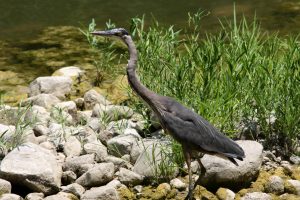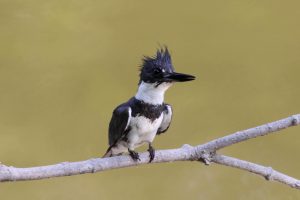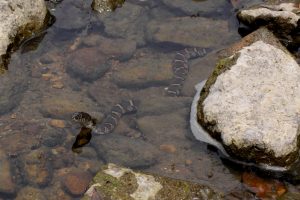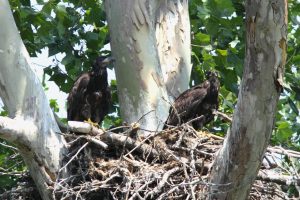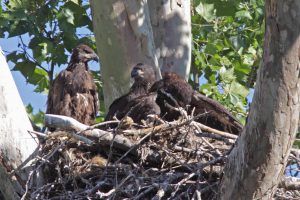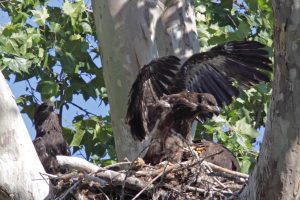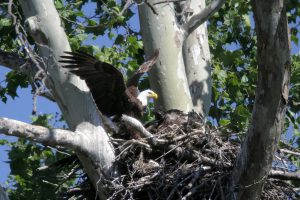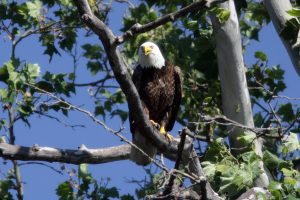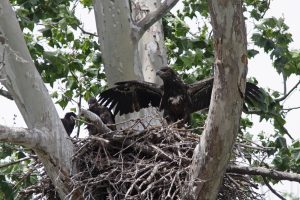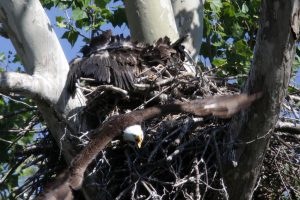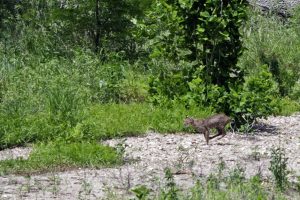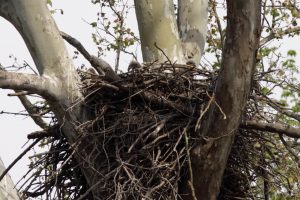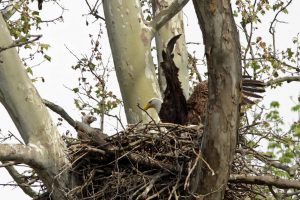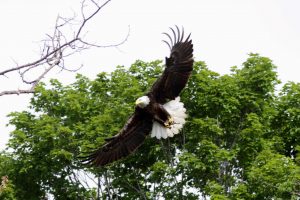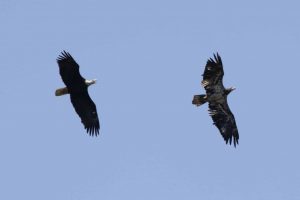This summer, Vermilion County resident, David Hale, has sent us some great photos of wildlife along the Middle Fork of the Vermilion River. Since the river was protected with a special federal designation in 1989, David has been eyewitness to the return of the animals that make it such a special place. In March of 2010, he noticed an eagle’s nest in a large Sycamore tree along the river. Ever since, he has been monitoring and photographing the eagles along with other wildlife that inhabit the area. We think the story is best told in his words, so the following are excerpts and photos from several email exchanges we’ve had with David. Please stay tuned for updates from the Middle Fork!
[See previous posts from June 11th, June 13th, June 27th, and July 3]
July 15, 2012
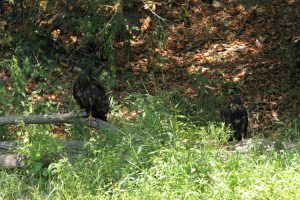
I visited the nest on Tuesday, July 10 and discovered that the oldest chick had returned to hang out near the nest. The other two were out of the nest and on the river bank below it. The bigger of the two was active, drinking water and flying short distances. The smallest seemed alert but wasn’t moving around much. I didn’t know if this was a normal transition from the nest or if they’d simply fallen for some reason. I returned early the next morning and saw that the smallest chick was weak and not moving.
Not sure what to do, I drove to Kickapoo Park and talked to John Hott, the park superintendant, and we decided to try and save it. With the help of John’s wife, we loaded the chick into a small animal crate and took it to the Wild Animal Clinic at the University of Illinois. Unfortunately, it died shortly after being dropped off. The clinic manager said it was malnourished and very dehydrated. It ain’t easy growing up to be an eagle; they have a 50% mortality rate the first year.
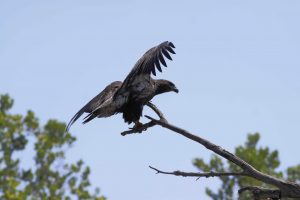
‘The watcher’ is a shot of the oldest chick sitting in a tree above me. ‘Thinkin’ about flying’ shows the two chicks on the ground, the one with it’s head down is the one that didn’t make it. When John and I were across the river, we took a look under the nest to see what the eagles had been eating besides fish. We found the remains of a small raccoon, three or four small softshell turtle shells, several unknown mammal skulls, and the tail of a mink.
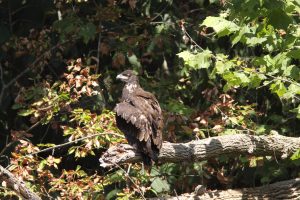
I took ‘Fridays photo’ when I went back to check on the remaining chick on Friday. The bird was on a sandbar with it’s older brother and one of the adults was sitting in the nest tree. The older chick and the adult flew off and the younger one hurried back across the river to its spot under the nest. It seemed strong and it’s flying farther so I think it’s got a good shot at making it.
Went to check on the eagle chicks this morning and discovered that the eldest has run off to join the circus or whatever it is that young eagles do when they leave home. I wasn’t too surprised as that one seemed on the verge of flying last week. I was curious whether it would hang around the nest area since the other two are still there but after five hours I’d seen no sign of it. I guess it’s probably out learning to fish. I suspect the remaining two will also be flying in a matter of days.
One of the adults came winging in carrying a fish skeleton. I don’t know if there was a little flesh left on the head that he was going to give to the chicks or if he just wanted a boney flag to fly for the Fourth. Either way, when he saw me he flew upriver and landed in a tree where he sat and sulked.
I threw in some bonus shots of Middle Fork regulars: a heron, kingfisher, and water snake.
June 27, 2012
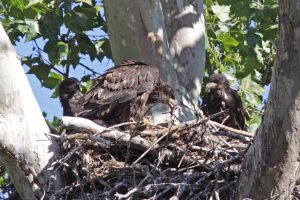 Spent yesterday morning at the eagles nest and thought I’d pass along my observations. They were feeding when I first arrived with one chick stooping over his meal while the other two watched. The biggest chick (in the background of the photos), had apparently eaten his fill and just watched as the others finished the leftovers. I’m not sure what they were eating but it must have been fairly large as it took the two of them 20 minutes to finish it off. Right after they’d finished the male came in carrying another fish, circled the nest, then promptly reached down and ate the fish himself. I don’t know if he did that because he could see the chicks had plenty or if he did it because I was there. One of last year’s juveniles showed up in the distance again, but quickly left when the male started flying toward it.
Spent yesterday morning at the eagles nest and thought I’d pass along my observations. They were feeding when I first arrived with one chick stooping over his meal while the other two watched. The biggest chick (in the background of the photos), had apparently eaten his fill and just watched as the others finished the leftovers. I’m not sure what they were eating but it must have been fairly large as it took the two of them 20 minutes to finish it off. Right after they’d finished the male came in carrying another fish, circled the nest, then promptly reached down and ate the fish himself. I don’t know if he did that because he could see the chicks had plenty or if he did it because I was there. One of last year’s juveniles showed up in the distance again, but quickly left when the male started flying toward it.
I’m planning on visiting the nest weekly in the hope I can catch them when they begin to figure out what those wings are for, so I’ll keep you posted.
Also, one of the gate guards at Vermilion reported seeing a bobcat with a half grown kitten on the road by the lake, so maybe there’s more of them than we think in that area.
June 13, 2012
I spent the morning at the eagles nest and they’re all doing fine. The pictures show one of the adults dropping a fish into the nest and then swinging out and around to perch above it. The fish wasn’t very big and lasted about as long as a snowflake on a hot griddle. The biggest chick seemed to get the lion’s share, which is probably why it’s the biggest chick! It’s already strong enough to lift itself into the air, so it’s only a matter of weeks before they leave the nest. No bobcat this time, but that’s okay. I’m holding out for a mountain lion next.
June 11, 2012
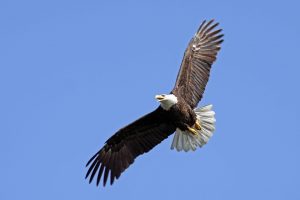 The eagle story began in March of 2010 when they built a nest in a large sycamore tree on the Middle Fork River near Kennekuk County Park. Being an amateur nature photographer, I was excited at the prospect of getting some eagle photos. Much to my amazement a pair of geese took over the nest and raised six goslings in it.
The eagle story began in March of 2010 when they built a nest in a large sycamore tree on the Middle Fork River near Kennekuk County Park. Being an amateur nature photographer, I was excited at the prospect of getting some eagle photos. Much to my amazement a pair of geese took over the nest and raised six goslings in it.
The next year, the eagles took back their nest and successfully fledged two chicks. This year they have three and all three seem to be doing fine. As far as I know this is the 2nd nesting pair of eagles in Vermilion County. The first pair is on the North Fork of the river.
David was also lucky enough to get an action shot of a bobcat, running up the riverbank. An encounter with this elusive creature is extremely rare, but David had his camera ready and was quick to react.
As for the bobcat, it was basically right place, right time. I was watching the eagles nest from the opposite bank of the river when I caught a flash of movement about fifty yards upstream. I turned and put the camera lens on it and managed to get two frames as it ran up a sandbank and then disappeared into the brush. I have heard all my life that there were bobcats in this area but this is the first time I have seen actual proof.


